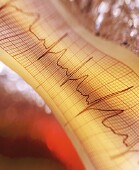Vagal activity tied to enhanced oxidative glucose utilization, not insulin sensitivity
MONDAY, June 29, 2015 (HealthDay News) — A low-calorie diet may improve heart rate variability (HRV) in obese patients with type 2 diabetes, according to a study published online June 12 in Diabetes Care.
Dan Ziegler, M.D., from the German Diabetes Center at Heinrich Heine University, and colleagues randomly assigned obese patients with type 2 diabetes to consume either a diet high in cereal fiber, free of red meat, and high in coffee (13 patients) or a diet low in fiber, high in red meat, and coffee-free (15 patients) for eight weeks. Measures of HRV and inflammatory markers were assessed.
The researchers found that both dietary interventions resulted in a mean weight loss of 5 to 6 kg, a mean decline in heart rate of four to six beats per minute, and improvement in vagally-mediated HRV. However, between the groups, changes in HRV parameters from baseline to eight weeks did not differ. Overall, change in HRV was associated with enhanced oxidative glucose utilization (P < 0.05), but not with insulin sensitivity and inflammatory markers.
“In obese type 2 diabetes patients, energy restriction per se over eight weeks contributed to improved cardiac vagal function in relation to improved oxidative glucose utilization,” the authors write. “This preliminary finding should be verified in a confirmatory trial.”
Copyright © 2015 HealthDay. All rights reserved.








